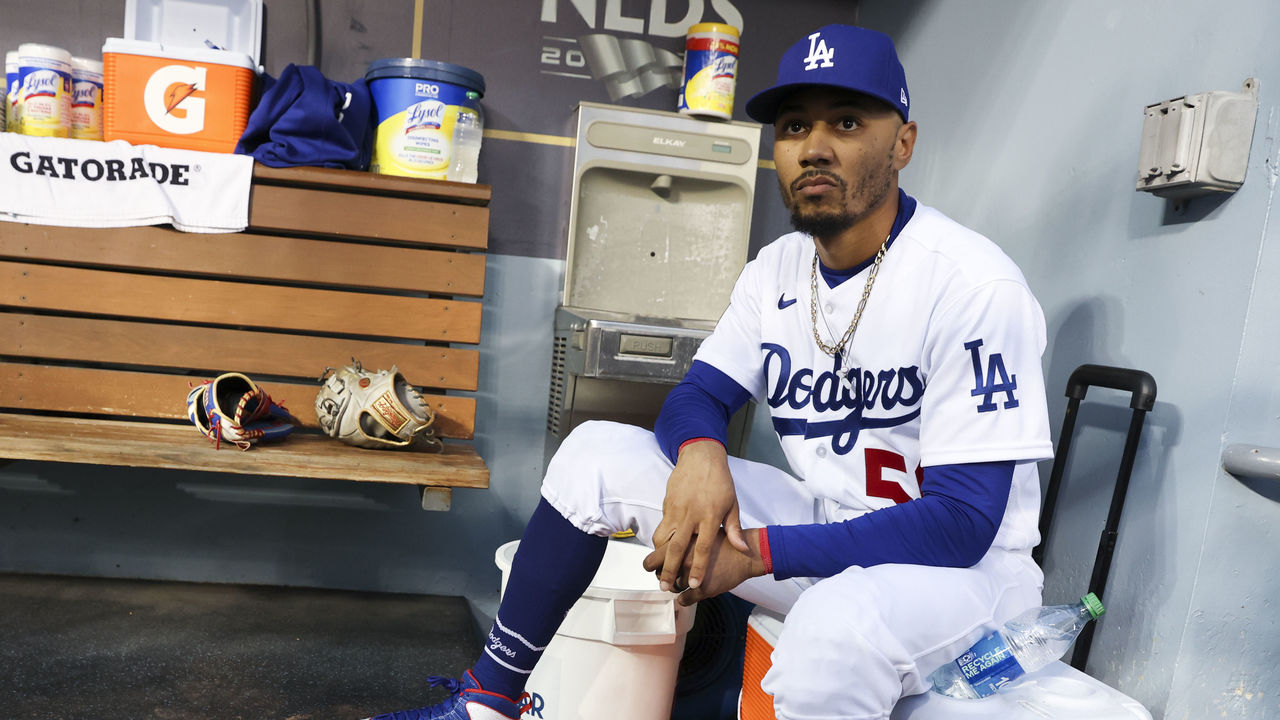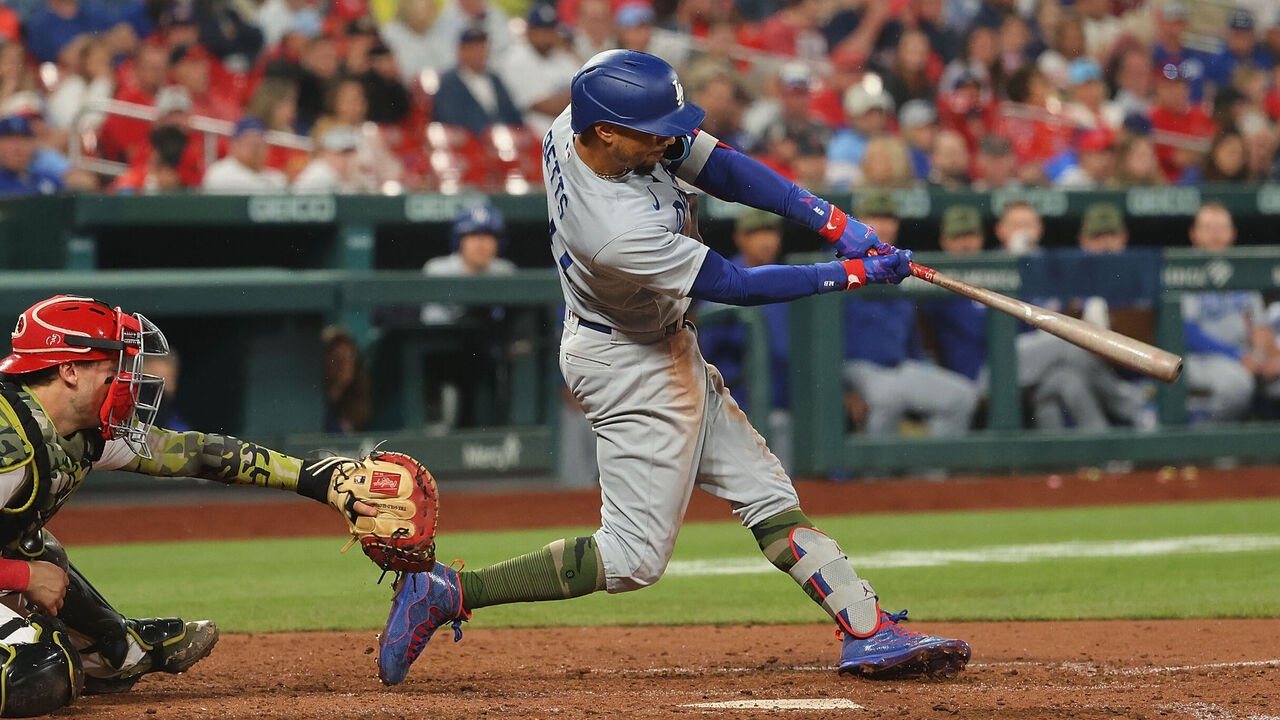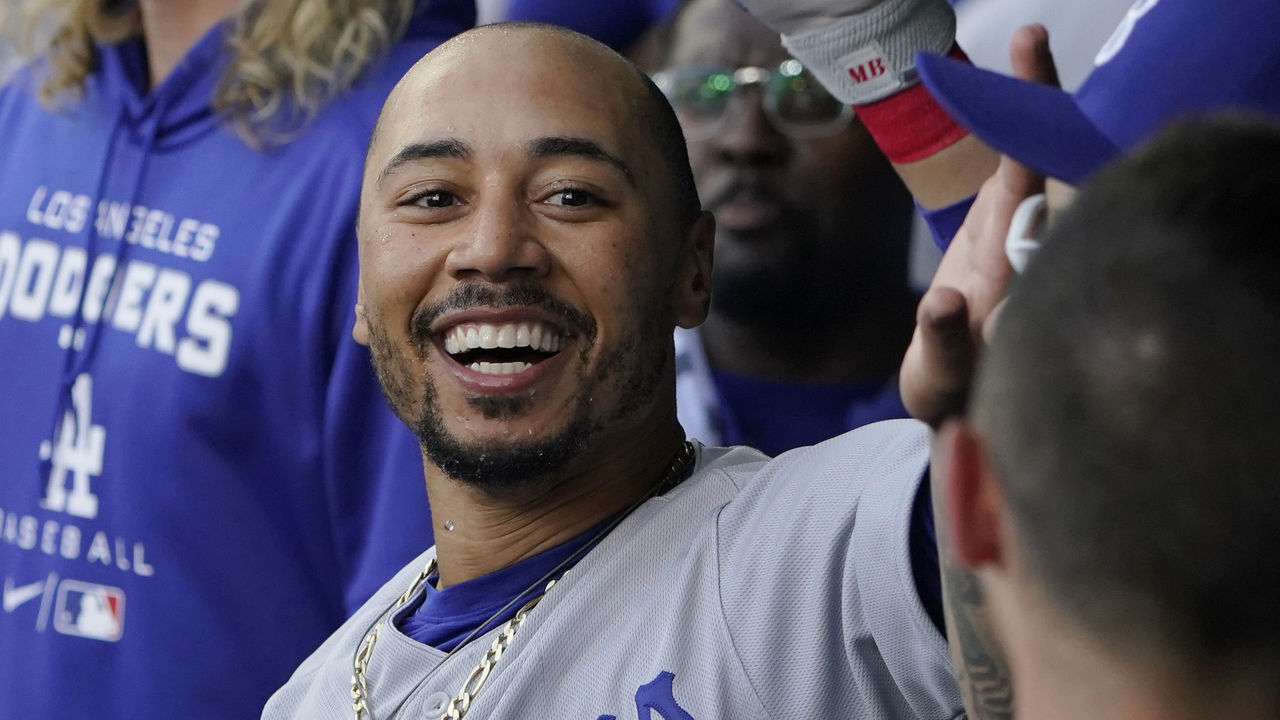Taking out the 'trash': How Mookie Betts revamped his swing at age 30
"I have this little theory. When I think about the best players, I think what makes people so good is when they have that insecurity about themselves because they don't want to fall off. It keeps them working. I feel like (Mookie Betts) had that little doubt. Other guys have good years and they won't make the change. He was like, 'Dude, I have to figure this out. I don't have it figured out.'" - J.D. Martinez on Mookie Betts in summer 2018
A few years ago, while working on a project about swing changes in the game, I asked Martinez why he thought his Red Sox teammate was so invested in retooling his swing that season.
After all, Betts entered 2018 as one of the game's best players. Yet he began working with Martinez, hitting coach Tim Hyers, and outside instructor Doug Latta on changes to improve even more. Betts became interested in better using his lower half in his swing. He learned how to more efficiently transfer energy through his kinetic chain, from his cleats' interaction with the ground up through to his hands. Betts went on to win the AL MVP that season.
Martinez's theory stuck with me. His thoughts were similar to the sentiment of Andy Grove, the late CEO of Intel, who titled his business strategy book "Only the Paranoid Survive."
But I never asked Betts about that Martinez quote. So I approached Betts, who's having another MVP-level campaign with the Dodgers, in the road clubhouse at Progressive Field in late August. Does doubt drive Betts to seek continuous improvement?
I was also curious what kind of changes, if any, he made recently, which have led him to his best season since 2018. He's already posted 7.5 fWAR and a career best in home runs (36). He enters play Thursday second in the majors in slugging (.611) and OPS (1.021), trailing only Shohei Ohtani. Betts might just win a second MVP this year.

Players usually don't get better at age 30.
To answer the Martinez question: Betts said he doesn't doubt himself in the batter's box. But he did say he was motivated to seek improvement over the winter after evaluating his last few seasons.
Why?
"They were trash," Betts said.
While not quite at his 2018 form, Betts did hit a previous career high of 35 home runs last year, and posted 131 and 144 wRC+ marks the last two seasons, along with 3.9 and 6.6 WAR marks.
"I just want to be the best player I can be," Betts said. "I was falling short."
I later relayed Betts' quote to Driveline director of hitting Tanner Stokey, who Betts worked with in the offseason: "That sounds like Mookie."
Betts is his own toughest critic. His MVP-level production this year can also be traced to a desire for continuous improvement, an acceptance that he doesn't have all the answers.
"Sometimes you cannot do it by yourself," Betts said. "You have to go find help."
So he did.
MOOKIE BETTS HAS A CAREER HIGH IN HOME RUNS
— Blake Harris (@BlakeHHarris) August 30, 2023
IT IS STILL AUGUST
pic.twitter.com/ywvDsODZHt
Back in December, Dodgers hitting coach Robert Van Scoyoc arranged for a number of his hitters to fly to Seattle to have biomechanical evaluations done at Driveline, the independent training facility in Kent, Washington. He also wanted to expose the players to a bat-speed training regimen.
Even a cutting-edge player-development club like the Dodgers is willing to outsource - or at least seek outside opinions on - what might help their players improve.
"We ran them through all their high-performance data, their strength assessments stuff," Stokey said. "We also ran them through their motion-capture assessments.
"We met with the coaching staff and went over that stuff with them. We went over it with the players and gave them some bat-speed programs to execute throughout the offseason."
Most of the Dodgers players embraced it. Mookie went further.
"With Mookie, specifically, he continued to work with us," Stokey said. They still communicate nearly every day.
"I was falling short," Betts said. "It wasn't for lack of effort or trying. I was looking for something that could point me in the right direction and at Driveline they did that."
The Driveline coaches were wowed by the biomechanical assessment of Betts' swing.
"As simply put as possible, he's one of the most efficient movers we've ever had inside of our motion-capture lab," Stokey said. "As far as his kinematic sequence goes, from start of swing to end of swing, the energy transfer was very much elite. The way he uses the ground on the force plates is also some of the highest percentiles we've seen. He's also very good at creating stretch, and getting the most out of a smaller frame."
Mookie Betts - High Fastball HR
— Trey Hannam (@TJHannam10) August 30, 2023
- Down To, Up Through pic.twitter.com/EtHglpBuyI
Betts is renowned for his rare eye-hand coordination and athleticism. You've probably heard about his bowling exploits. Those innate gifts help make him one of the elite "ball-strikers" in the majors, Stokey said. And he's needed those gifts, with a listed playing size of 5-foot-9 and 180 pounds.
But when Betts entered Driveline, he'd just turned 30.
His batting average was below .270 two years in a row. His strikeouts hit a career high, eclipsing 100 in a season for only the second time (104). While Betts enjoyed hitting 35 home runs, his overall performance irked him. He'd drifted away from his 2018 form.
While Betts had excellent movement patterns, Stokey thought his team could help him in some specific areas.
"He was the perfect candidate to add a little bit of bat speed, especially with where he is at in his career, a little bit older," Stokey said. "Father Time is undefeated, right? Everyone is going to start losing some speed. So with him, there was definitely some low-hanging fruit where he could gain some (bat) speed."
Betts began a regimen, which he's maintained through the season, that calls for him to swing a bat 20% heavier than his game bat and also swing a bat that's 20% lighter. The differential, or underload-overload training as it's known, is similar to the weighted-ball programs on the pitching side that are partly responsible for velocity gains in the game.

"I think the only thing we (hitters) have, really, is bat-speed training," Max Muncy, who also went to Driveline last December, said from a few locker spaces away. "At the end of the day, pitching will always be ahead of hitting. That's just how it is."
Bat speed correlates strongly with exit velocity, and exit velocity is the most important underlying factor in determining quality of contact on the field.
Bat Speed and Exit Velocity: The Basics
— Kyle Boddy (@drivelinekyle) August 28, 2023
Let's explore how well bat speed predicts how hard you might hit the ball - to do this, we can use the @DrivelineBB OpenBiomechanics dataset and ChatGPT.
Using @OpenAI's Advanced Data Analysis tool (formerly Code Interpreter), we can… pic.twitter.com/x6iXP5KmxL
"There is a strength-training, resistance element to (the heavier bat)," Stokey said of the bat-speed program. "With the underload (lighter) bat, there is a speed element, kind of working fast-twitch muscle fibers a little more. With the differential training, you are also going to work on some mechanical efficiency, getting your body in a little better position."
There's also the element of intent, Stokey said. The program trains players to think about swinging faster.
Betts takes a combined 30-40 swings most days with heavier and lighter bats in addition to his regular hitting routine. He texts with Stokey about workload management, and Stokey also provides advanced scouting reports on opposing pitchers.
The strength staff at Driveline also recommended Betts add muscle mass by changing his diet and workout routines.
"It was really getting stronger. Building strength," Betts said. "Working out more. Heavier weights."
Driveline Trainee Mookie Betts has been on a tear lately and making a strong case to be MVP this year, take a look back at his visit to Driveline this off-season 🔥🙌 pic.twitter.com/NEHFrxYAkb
— Driveline Baseball (@DrivelineBB) August 29, 2023
Betts still doesn't look much like a power hitter at the plate. But he's added about 10 pounds of muscle.
The end results?
Driveline's analysis of his game swings in 2022 found he averaged about 71.7 mph in bat speed - a tick below the MLB average. This season, Betts is averaging 72.7 mph.
It's a meaningful bump. It's resulted in Betts' average exit velocity jumping to 92.7 mph, a career best, and up more than 2 mph from last season (90.5). It's the 30th-best year-over-year change in the majors.
He hadn't posted an average exit velocity of 92 mph or greater since 2018 (92.3).
Betts also made slight changes to his bat path in consultation with the Dodgers hitting staff and Stokey. Betts' average launch angle is at a career-best 20.4 degrees, and he's also maintained an infield fly-ball rate below his career rate (8.2% vs. 10.2%), and career-best barrel rate (13.8%).

He's simply hitting the ball harder and more squarely than at any point in his career.
I asked Stokey if he believed Betts' mindset was unusual even among pro athletes.
"Most, if not all, big-leagues guys are cut from that cloth. They are very competitive and not satisfied," Stokey said. "But a guy like Mookie, who is very likely going to end up as a first-ballot Hall of Famer, those guys are wired a little differently. All I know about Mookie is from December on, and all I know is he wanted to get better.
"He genuinely cared about getting better, which is impressive to say coming from a guy who has had as much success as he's had."
Travis Sawchik is theScore's senior baseball writer.
HEADLINES
- Kerr: Timeout blowup with Draymond 'not my finest hour'
- Harbaugh: Relationship with Lamar 'A-plus' amid reported tension
- Kittle uncertain to play vs. Bears after missing Wednesday's practice
- Watt returns to practice 2 weeks after lung surgery
- Former NBA 2nd-round pick Nnaji joins Baylor with immediate eligibility